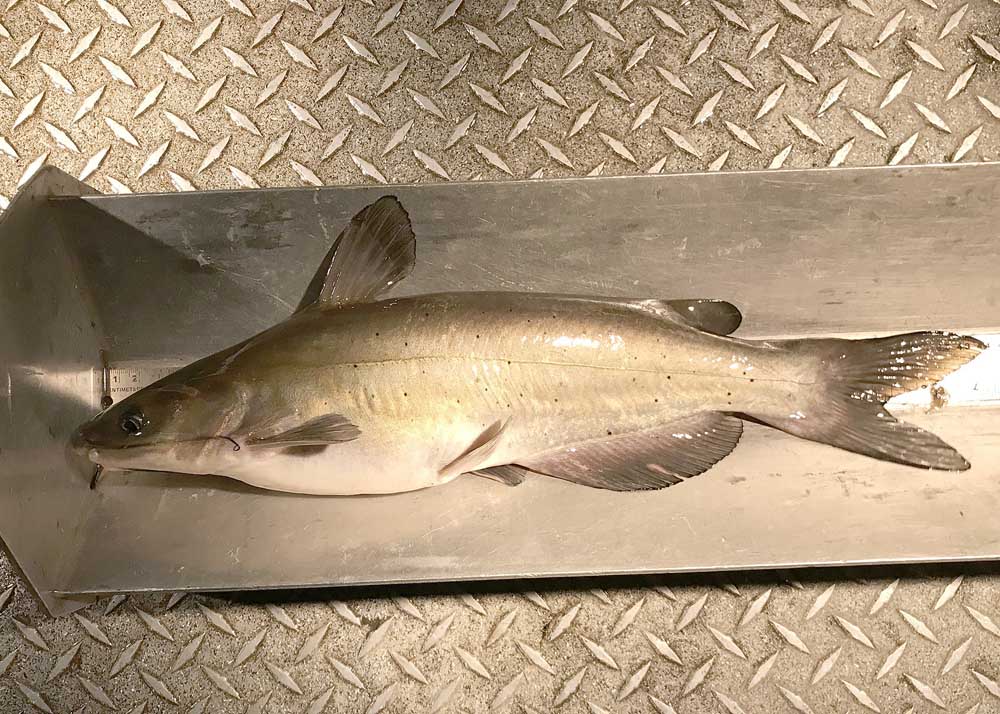Fishing for catfish on the Snake River: Stink is the thing
Published 3:00 pm Tuesday, July 4, 2023

- This photo from the Oregon Department of Fish and Wildlife shows a channel catfish.
The water was big and brown, the willows flooded past the shoreline. It was not likely to matter to the catfish. If anything, they probably like it better when they can scoot up into a cow pasture and retreat to the river again when the sun comes up.
Cousin Neil turned the North River sled in a wide arc and triangulated the position, a point of rocks on this side and a gravel bar on the other, just upstream of an overhanging tree, a skosh closer to the Oregon bank than the Idaho side, just out of the main current.
I tied on a length of braided line beneath a big snap swivel and, with a palomar knot, tied on a 3–ounce lead ball, and then a No. 4 treble, and another one 12 inches above it. A simple in-line presentation for the flat bottom of the Snake.
Up front, cousin Matt slipped the big hook over the side and Neil powered back to set the anchor in position. Trevor Barclay called out the depth at 37 feet. A couple of fish showed low in the water column. Amy Lewis kept a hand on the back of 5-year-old Tabor’s life jacket. She had a couple of secrets: She hated fishing for catfish and she had brought a big bunch of bananas. Neither of these things did she reveal until later.
I thumbed the reel, flipped the lever into free-spool, and fed line behind the boat. When the weight touched bottom, I walked it back till the line counter read 58.
Our baits consisted of a chunk of shrimp with a chunk of nightcrawler. To further stinkify the offering, I applied Pro-Cure fish oil and garlic plus.
It was a matter of minutes before Matt caught a fish and then a few minutes more till he caught another, both 15-inch channel cats. After that we didn’t catch another less than 20 inches long. Both channel cats and flathead catfish can get big in the Snake River where it marks the border between Oregon and Idaho.
Stink is the thing. We didn’t buy shrimp till the last minute and they looked good enough to eat. What a person wants to do is let those shrimp sit in the sun and get a little ripe. But of course, catfish baits are a highly developed art and you don’t need a fly-fishing snob to tell you how to catch a big one. I’m still trying, but I do know I had the stinkiest bait on the boat, and it wasn’t long and I was fighting the biggest catfish of my life. Now, I haven’t caught a lot of cats, so when I caught a 5-pounder, it was a personal best. And when I caught a 6-pounder, it was a new personal best.
Tabor netted almost every fish and we kept a few for catfish po’boy sandwiches and let the rest go.
There is a rule about bringing bananas on the boat. You don’t do it. It’s bad luck, but Amy had grabbed the wrong bag off the counter and now we had bananas. We finally decided to destroy the evidence and everybody ate bananas while the catfish continued to climb on our baits. As night drew closer, we caught bigger ones. And then Amy divulged her other secret: She hated catfishing. “It’s so boring,” she said, “and I’ve never caught one.” She changed her tune as soon as her rod bent over with a 5-pound channel cat.
On toward dusk we saw fishermen with buckets of bait and their chairs setting up on the banks. A few jet boaters pulled into position off the main current, and we heard snatches of conversation. Although the numbers of fish didn’t pick up with nightfall, the fish were bigger, running 6½ pounds now. All of a sudden we had a new catfisher-woman in our ranks, apologetic about the bananas, but unabashedly enjoying herself. I wanted a bigger fish. And I could now add a flathead catfish to my life list.
I did not bring the wrong rod: a 9-foot Castaway, built for salmon with the reel loaded with PowerPro braid. I haven’t caught a lot of fish on this rod, but it is my new catfish tamer. After dark I clamped on bells and a little chem light at the tip. Finally the bells rang and a fish almost ripped the rod out of the holder. I fought the fish for six minutes before Tabor got the net under it and lifted it into the boat. “I’m strong,” the 5-year-old proclaimed. It was a pretty good lift for the boy fisherman, and when we put the fish on the scale it weighed in at 8 pounds, 12 ounces, my new personal best channel cat. I let it go into the dark water and watched it kick away.
By the time we were off the water we had another family reunion in the works. Tabor will be bigger next year, and stronger, and we will bring a bigger net. And stinkier bait.
One June morning drifting a near-flood-stage Wyoming River called the Salt, we rounded a corner to where a short tributary was pumping clear water out of a side slough.
The creek was crystal clear and cutthroat were rising to mayflies. One landed on my wrist and we had the answer. It was a gray drake. We lengthened our leaders to 12 feet with 5X tippets, greased the flies with floatant and managed to take several fish in the slow, clear water.
It’s an important hatch on some western rivers like the Henry’s Fork, the Madison and the Firehole. Look for these bugs early June to mid-July, usually in slow to medium fast water.
Tie this one with gray thread on a No. 10-12 dry-fly hook. If tying in a tail, use fine stripped hackle tips. Build the spare body with a few wraps of gray floss. Use fine white thread for the rib. Tie in a white poly (or calf tail) wing post. Finish with a grizzly hackle tied parachute style.
—Gary Lewis, For The Bulletin






